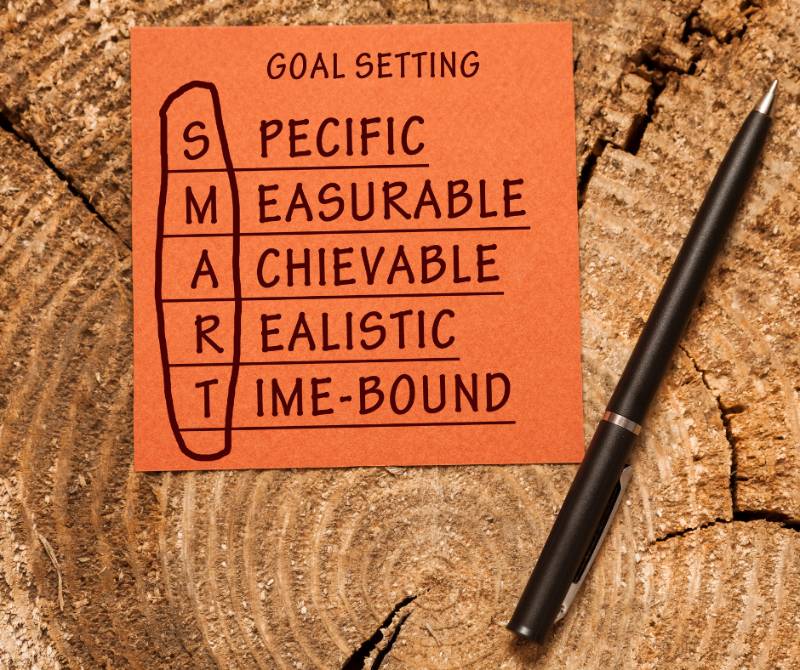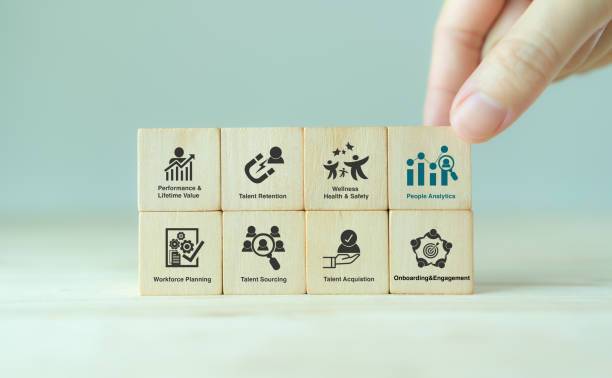Project planning is crucial to achieving your goals. It helps you see things in a broader context and ensures you don't miss any critical steps.
In other words, it's crucial to set realistic goals for a project. But how do you know if they are practical and doable? The truth is that you need to ensure that your goals are within your reach. You can't just set an arbitrary goal and expect it to be achieved.
In this article, I will explain what a realistic project goal is, how it differs from a project objective, and how to achieve desired results.

 What are project goals?
What are project goals?
A project goal is the end result of a project. It can include the product you want to build or the result you want to achieve. It could be something like "make a new website with a beautiful user interface" or "increase our sales by 10% in a year". Your project goal is a quantifiable goal that you can use as a basis for planning.
To understand what goals you should set for your projects, you need to consider the type of project you are working on. Are you building a website? Maybe you are designing a video game? Or perhaps you are trying to complete a creative writing assignment for class?
Regardless of what type of project you are working on, your goals are the same: you want to create a specific outcome. Whether it's a website, a video game, or a story, you want to end up with something good, interesting, or valuable.
 What are project objectives?
What are project objectives?
Let's clear up some confusion. What exactly are project objectives, and how do they differ from goals? Think of project objectives as the stepping stones that help you achieve your ultimate project goal. Goals are the big picture, while objectives are the smaller, measurable, and time-bound targets that keep your project moving forward.
With that in mind, how can we determine realistic goals for a project?
- Understand your project's scope: Make sure you have a clear understanding of the project's requirements, stakeholders' expectations, and available resources. This knowledge lays the groundwork for setting achievable goals.
- Break it down: Tackle those big, lofty goals by breaking them into smaller, manageable objectives. Remember, Rome wasn't built in a day!
- SMART approach: Utilize the SMART criteria (Specific, Measurable, Achievable, Relevant, and Time-bound) to create clear and realistic objectives.
- Risk assessment: Identify potential risks and challenges, then plan for them. Be prepared for the unexpected and stay flexible!
- Collaborate: Communicate and collaborate with your team. Their input and expertise can help shape your goals and objectives.
 Project goals vs project objectives
Project goals vs project objectives

There are two significant differences between project goals and project objectives.
A project goal is quantifiable, specific, measurable, and actionable. You know what it is, and you can write it down. Here are some examples of a goal:
- Publish the top 100 most popular blog posts on my site each month.
- Develop a video game that will be a blockbuster hit with audiences in multiple countries.
- Grow my business.
- Get a better job.
- Learn a new skill.
Project goals are generally broad, but they are clear. You know precisely what you want. You can get an idea of when you will be done, too. But you can also break down that goal into smaller, more manageable chunks.
Project objectives, on the other hand, are much more specific; they are steps that must be taken to achieve the result of a project. In short, they are milestones.
If your goal is to develop a video game, a section of your project objective could be something like this:
- Create a playable first level that will orient them to the game controls and give the players an idea of the main character
- Create multiple types of obstacles to overcome and enemies to kill.
- Add enemy A.I. with variable intelligence and adjustable difficulty levels.
- Add a boss fight to mark the end of Level One.
- Another example is if your goal is to revise your existing website, your project objective could be something like this:
- Create a new homepage with a different colour scheme.
- Create a layout for the homepage with a revised landing page.
- Add social media integration.
- Integrate contact forms.
Because it is more efficient, project objectives are broken down into small steps. You can still break down a simple action like "creating a homepage with a different colour scheme."
For example:
- Research which template to use
- Find out what colour combination is more appropriate for the target audience.
- Research which plugins to use.
- Study and implement required coding.
These are all things that can be done separately, or if the steps or tasks are assigned to a team, they can be done in different timeframes or all at once.
The critical thing to remember is that they are all connected, and every single one needs to be met to complete the project.
In summary, when it comes to project management, project goals define the result of what you are trying to achieve. Project objectives are concrete steps you need to take to reach each milestone and, eventually, the end result.
 How to Determine Realistic Goals for a Project in 6 steps
How to Determine Realistic Goals for a Project in 6 steps

Project management is the process of planning and keeping track of resources while a project is being developed and put into action. It can be difficult if you are a beginner. A lack of experience may lead you to set unrealistic or impractical goals that would delay the progress of a project. As such, it's critical to follow a 4-step guide when setting realistic goals.
Step 1: Define project goals
To start, you must clearly define your project's goal. Without a defined goal, there is no way of measuring whether or not you have been successful. The more clearly you define your project's goal, the better your chances are of reaching it. When describing a project goal, start with the result and work backwards.
For example, if your project's goal is to redesign your product's website, you must first figure out what that entails.
Let's use the website revision project as an example. Your goal could be something like this:
The website should make it easy to get to all the important pages and have a layout that works well on different devices.
Next, you can decide on the features and functionality you want to be included in the new site. Perhaps it should include upgraded user registration and an account management system that allows users to sign up for a free account quickly, or maybe it will include a blog feature.
By defining the goals of your project, you and your team can set a timeline for when you expect the project to be finished and give each task a clear place to start. Your goals should also be clear to everyone to track how far the project has come and how much longer it will take to finish.
Step 2: Create an action plan
Once you have defined the goals and objectives of your project, it's time to move on to the next step—defining the methods that will be used to achieve your goal. This might include brainstorming ways to implement the new design or updating existing content.
Your action plan may include the following components:
- Write down the steps needed to complete your project.
- Describe the roles, skills, and resources required.
- Specify when and how often you will review the action plan.
- Define the milestones for the project's completion.
- Describe the deliverables for the project's completion.
- Include a detailed schedule and description of how much time it will take to complete the project.
- Set deadlines for each milestone and, overall, the project.
Once you have written down everything, you can share it with your team members to ensure you are all on the same page.
Step 3: Explain your team their objectives
At this stage of your project, you must communicate with your team exactly what your goal is. It is also essential that your team understands why they are working on this project and what they expect to accomplish.
This will ensure that everyone on your team works toward the same goal and will help you avoid misunderstandings.
Also, be sure to set some expectations for yourself and your team. For example, you might state that you expect the work to take four days, while you know you will need six days to complete the job. You can also ask your team to prepare and submit their weekly update at the beginning of each week. This will allow you to see the progress and any issues that have come up along the way and ensure that you can solve any problems that arise.

Step 4: Align your goals with your resources and constraints
At this stage, you've defined your objectives, broken them down into smaller tasks, and ensured they are SMART. Now, it's time to take a deep breath and align your goals with the resources and constraints at hand. Remember, it's all about finding that sweet spot between ambition and feasibility. So, let's dive in!
- Assess your resources: Start by asking yourself some questions. What kind of resources do we have at our disposal? These might include financial assets, human capital, time, or even physical materials. Jot down everything you have and how much of it you can allocate to the project. This exercise helps ensure that our goals remain grounded in reality.
- Identify potential constraints: Life is full of surprises, and projects are no exception. What obstacles might we encounter along the way? Time constraints, budget limitations, or even unforeseen circumstances could hamper our progress. Being aware of these hurdles enables us to prepare for them and adapt our goals accordingly.
- Time: Can we complete the project within the given timeframe?
- Budget: Are our financial resources sufficient to achieve our goals?
- Human resources: Do we have the right people with the right skills on our team?
- Prioritize and adjust: Sometimes, it's necessary to make tough choices. If we find that our resources and constraints don't align with our goals, we need to adjust accordingly. It could mean prioritizing certain aspects of the project or scaling back our ambitions.
- Keep a realistic mindset: It's important to remember that setting realistic goals doesn't mean sacrificing our dreams. Instead, it's about striking a balance between aspiration and pragmatism. By keeping our expectations grounded, we set ourselves up for success and minimize the risk of disappointment.
Step 5: Determine the Critical Success Factors
When determining critical success factors, you're identifying the key elements that are absolutely necessary for your project to achieve its goals. These factors could include the availability of specific resources, such as a specialized software tool or skilled labor, that are essential to complete the project. Additionally, stakeholder approval might be a vital factor if you need to secure funding or access to other resources. Specific deliverables, like a proof of concept or a minimum viable product, may also be critical to advancing the project to the next stage.
Determining these critical success factors enables you to allocate resources wisely, prioritize tasks effectively, and understand where to focus in case of problems or delays. For example, if you know stakeholder approval is a critical factor, you might prioritize meeting their specifications over less vital tasks.
Step 6: Continuously Monitor and Adjust Goals
Once your project is underway, it's essential to understand that goals aren't set in stone. Factors such as changes in market conditions, stakeholder expectations, or even your team's capabilities may necessitate goal adjustments. Regularly schedule review sessions to go over progress and discuss any external or internal changes that could impact the project. Use key performance indicators (KPIs) to measure how closely you're tracking against your goals and milestones.
By monitoring your goals, you give yourself the flexibility to adapt, which is crucial for navigating challenges that inevitably arise in any project. For instance, if a resource you considered "plentiful" suddenly becomes scarce, you may need to reevaluate your strategy, update your risk assessments, and adjust your goals accordingly. Continuous monitoring and adjustment ensure that your project remains relevant, achievable, and aligned with both short-term milestones and long-term objectives.
As you embark on your project, always keep in mind that a realistic goal is one that is achievable given the resources and constraints you face. By following these steps, you'll be well on your way to setting and achieving goals that are both ambitious and attainable.
 Implement S.M.A.R.T. objectives framework
Implement S.M.A.R.T. objectives framework
S.M.A.R.T means Specific, Measurable, Actionable, Realistic, and Time-Based.
It's a standard measure of performance that helps you set goals and objectives for your team and your project. Here is a quick breakdown of how you can apply this framework when setting realistic goals for a project:
SPECIFIC: What exactly do you want to achieve with this project? Be specific; make it easy to measure. Example: "Design a landing page that allows users to sign up for a free newsletter."
MEASURABLE: Make sure your goals are measurable. Example: "This goal is based on the number of conversions daily."
ACTIONABLE: Break down your goal into small steps. For example, if your goal is to increase conversions by 15%, break down the goal into "Design a landing page that allows users to sign up for a free newsletter." You can create sub-goals to achieve this larger goal. For example, "Create an email template that increases conversion rates."
REALISTIC: The word "realistic" doesn't just mean you're being overly optimistic. Set your expectations appropriately so that they are measurable. A realistic expectation is based on data. Example: Based on the data, we're aiming for a 10% conversion rate with the improvement of the landing page.
TIME-BASED: This is another one of those "duh" things, but still significant. Set your goal in terms of time or activity, not just numbers. Example: "Increase the conversion rate by 1% each week."
 5 Project goals and objetives examples
5 Project goals and objetives examples

Now, let's take a look at five project goals and objectives examples to fuel your creative thinking:
Launch a new product line
- Objective 1: Conduct market research by [date]
- Objective 2: Finalize product design by [date]
- Objective 3: Secure production resources by [date]
- Objective 4: Develop a marketing strategy by [date]
Improve customer satisfaction
- Objective 1: Implement a customer feedback system within three months
- Objective 2: Train customer service representatives on empathy and problem-solving
- Objective 3: Reduce response time to customer inquiries by 50% in six months
Increase website traffic
- Objective 1: Optimize website for SEO within two months
- Objective 2: Publish four high-quality, engaging blog posts per month
- Objective 3: Launch a social media marketing campaign within three months
Streamline internal communication
- Objective 1: Evaluate current communication tools and identify areas for improvement within one month
- Objective 2: Implement a new communication platform within three months
- Objective 3: Train employees on effective communication techniques and best practices
Reduce project delivery time
- Objective 1: Assess current project management processes and identify bottlenecks within one month
- Objective 2: Implement a new project management methodology within three months
- Objective 3: Train project managers on time management and prioritization techniques
 Benefits of Setting Realistic Goals for a Project
Benefits of Setting Realistic Goals for a Project
Setting realistic goals for a project is not just a good practice; it's essential for the successful completion and long-term sustainability of the project. Below are some of the key benefits of setting realistic goals:
Improved Focus and Prioritization
When the project goals are realistic, it's easier for the team to focus on what's most important. They can prioritize tasks and resources more efficiently, which, in turn, can speed up the project's completion.
Increased Team Morale
Realistic goals are achievable, and achieving goals boosts team morale. When team members see that their hard work leads to real results, it increases their engagement and motivation to perform even better.
Better Resource Allocation
With clearly defined and realistic goals, you can make better judgments about what resources (time, human capital, money, etc.) are truly necessary. This enables more efficient use of resources, reducing waste and increasing the likelihood of project success.
Enhanced Stakeholder Confidence
Stakeholders, including clients and upper management, are more likely to trust a team that sets and meets realistic goals. This confidence can lead to more opportunities for future projects and career growth.
Easier Monitoring and Controlling
Realistic goals are usually more straightforward to measure, making it easier to track progress. This simplifies the monitoring and control stages of project management, helping to quickly identify and correct any deviations from the plan.
Risk Mitigation
When you set realistic goals, you have a better understanding of the potential risks involved. This allows for better planning and preparedness, thus mitigating the impact of any risks that do materialize.
Greater Accountability
Because realistic goals are measurable and time-bound, it's easier to hold team members accountable for their roles in achieving them. This fosters a culture of responsibility and results-orientation.
Customer Satisfaction
Last but not least, setting and achieving realistic goals often lead to a higher-quality end product, which is likely to satisfy or exceed customer expectations. Happy customers are often repeat customers, and they may also refer others to your services.
 Conclusion
Conclusion
Setting realistic and practical goals for a project separates successful from unsuccessful projects. Setting a clear path to your goals and objectives will allow you to see where you are lagging and track the progress of a project more efficiently.
Efficient project management requires the right tracking tools. While many software programs on the market allow you to track a project's progress, most are too expensive, especially if you only have a small business and budget.
In my experience, Kanban-style project management software is the most efficient. It allows you to visualize and keep track of your tasks and project progress on a single platform.
My team's favourite project management software is Edworking; it's free to try, scalable, and doesn't require an arm and a leg if you want to use the full features. Click here if you want to check out the features of Edworking and for those eager to measure their management capabilities, Edworking offers this free online Management Aptitude Test.
 FAQs
FAQs
What happens if the project goals are unrealistic?
When project goals are unrealistic, it can lead to a range of negative consequences including employee burnout, wasted resources, and project failure. Unrealistic goals can demoralize the team and set the project up for failure from the outset, as achieving the set objectives becomes practically impossible. This can also tarnish the reputation of the team and stakeholders involved.
How do I know if the project goals are realistic?
Determining the realism of project goals involves a multi-step evaluation process. This usually includes conducting a feasibility study, consulting with team members and other stakeholders, and comparing the project objectives against similar past projects. Additionally, the SMART criteria—Specific, Measurable, Achievable, Relevant, Time-bound—can serve as a useful framework for evaluating the goals.
Why is it essential to set realistic goals for a project?
Setting realistic goals is crucial for the success of any project. Realistic goals provide a feasible path for the project, aligning expectations and helping to allocate resources efficiently. Unrealistic goals can lead to disappointment, waste of resources, and can even jeopardize the entire project. Realistic goals also help in motivating the team and maintaining a positive work atmosphere.
How often should the project goals be monitored and adjusted?
The frequency for monitoring and adjusting project goals can vary depending on the nature and duration of the project. However, it's generally advisable to review goals at major project milestones or at least quarterly. Frequent monitoring allows for timely adjustments and helps keep the project on track. Adapting the goals as needed can help in reacting to unforeseen circumstances, thereby increasing the likelihood of project success.
What steps can be taken to make sure the goals remain realistic?
To ensure that goals remain realistic, it's advisable to conduct regular check-ins with team members and stakeholders, reassess resource allocation, and perform ongoing risk assessments. Using project management tools and KPIs can also provide quantitative measures of progress. Continual monitoring and the willingness to make adjustments are key to maintaining realistic and achievable goals.












